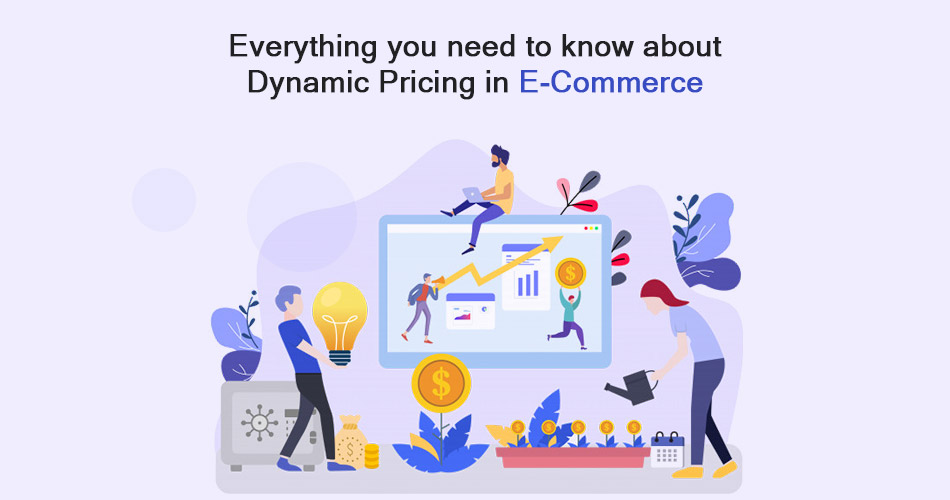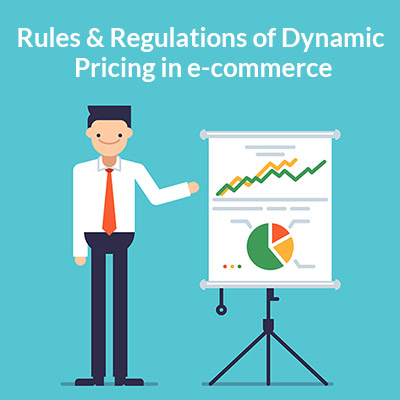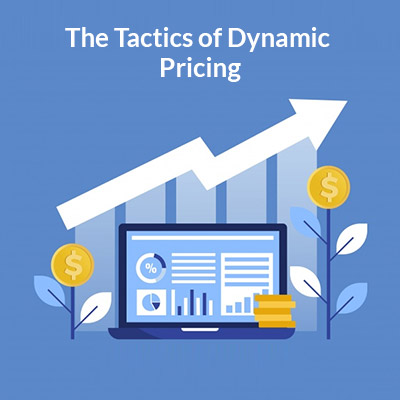
What is Dynamic Pricing?
Do you want to change your product prices in real-time as per market conditions?
Well, Dynamic pricing might be the right answer to this question.
Dynamic Pricing: A pricing strategy to set and fluctuate the prices of your product, based on a variety of factors like real-time supply and demand, customer’s buying pattern, competitors price, seasonality of the product, market trends, etc.
In simple words, dynamic pricing means setting discriminating prices for different buyers.
In this highly competitive world, the dynamic pricing strategies are not only restricted to the e-Commerce business. Hospitality, travel, entertainment and retail industry is also taking the benefit of this effective business model. Although this model is not the latest innovation but it has started gaining popularity with the increasing competition among various industry segments.
Here’s everything you’ll find in this article:
- History of Dynamic Pricing
- Top Companies using Dynamic Pricing Business Model
- Benefits of Dynamic pricing in e-Commerce Business
- Rules & Regulations of Dynamic pricing
- What Modern Pricing Analyst do?
- Tactics of Dynamic Pricing
- Get started with Dynamic Pricing
The history of Dynamic Pricing
1980’s: This concept was first used by American Airlines.
21’ st: This tactic becomes popular among e-commerce business.
Top Companies using Dynamic Pricing Business Model
Amazon: Amazon is a big fan of repricing! That’s why it changes its costs like every 10 minutes on average.
Walmart: Changes its prices approximately 50,000 times in a month.
How dynamic pricing can boost your e-commerce business?
By changing the price of the product as per market demand, your e-commerce business has the power to enjoy higher profitability on each product. The decreased price doesn’t always mean a declined profit.
Some of the benefits are listed below:
- Increased profit margin and sales.
- Complete control on pricing.
- Competitive edge over competitors.
- Quick response to demand and supply instability.
- Eliminates the manual process of checking the Competitor’s price.
- Provide insights on market trends.
When used only where it is actually required with accurate business insights, dynamic pricing in e-Commerce can do wonders. Implementing an effective dynamic pricing master plan ensures that your e-store will remain price competitive despite the changing market conditions.
Rules & Regulations of Dynamic pricing in e-commerce

Do not follow your competitors blindly
Most of the people have the perception that if they fix the prices followed by the industry standards and competitors, it is the safest course of action. Just because your competitors have lower down the price doesn’t mean that you also have to follow the same trend.
Setting the price as per Industry Standards and Competitor’s price is certainly not always the right approach to repricing. But yes, this is one of the best approach to fix your product prices. Apart from the competitors prices, use your internal metrics to determine the price at which your profit margin is high and the customer’s buying friction is low.
It’s all the game of time
The pricing rule shall be based on stock level, sales volume, and consumer purchasing behavior in the target market. It’s imperative to understand the pricing norms and patterns of your industry, factors playing the major role in consumer purchasing behavior, targeted customers profile, and many other factors.
“Offering the right price at the right time to the right customer is important in today’s competitive e-commerce world”.
Dynamic Pricing in e-commerce shouldn’t cross its limits
While repricing the products, do not forget to consider the indirect product cost. This may include the currency exchange fee, warehousing cost, transportation cost, etc. Also, set the over-pricing limit which states that the price of a particular range of products won’t be more than xxx percentage higher than xxx competitors. Keep testing your price and re-evaluate if required.
Capture seasonal Demand opportunities
The e-commerce giants are using dynamic pricing business model on various products that have seasonal demand. For e.g, the American product Pumpkin Pie Spice is popular during Christmas. The price of this product goes high just before Christmas. Because of the urgency of the product and low price sensitivity, customers are willing to pay even at a higher price than the usual price. When price sensitivity drops, the e-retailers can re-price the seasonal products to earn more.
Don’t over-rely on Dynamic Pricing e-solution and neglect human intelligence
Dynamic Pricing in e-commerce can be greatly assisted by various dynamic pricing e-solutions. But these should not be used in isolation without human intelligence. Although these software are well equipped with advanced features and latest technologies, but the human sense of judging the market trend shall not be ignored.
What Modern Pricing Analyst do?
The successful of dynamic pricing doesn’t depend upon the price changing speed, but on the smart use of accurate data to make pricing decisions.
They use Accurate Competitors Data
An effective dynamic pricing strategy begins with the competitors’ data. This pricing data is used to set the range of prices used to stay competitive. That’s why the collected data should be perfect and as accurate as possible. The modern analyst uses the most accurate data to the process of price optimization.
Price testing
Once we have accurate data, we can determine the most competitive price of the products. We can do A/B testing of the pricing strategies, analyze how different prices can affect the buyers purchasing decision, conversion rate and overall sales revenue. The pricing analyst finds the price that wins a lot of conversions and sales and then compares it with competitor’s prices at that time. If the prices are higher than competitor’s price and still we are getting a good volume of sales, it is suggested to hold the command on premium prices.
They follow Dynamism Not Discrimination
The demographics, customer’s source of visiting your e-store (e.g., MacBook or PC) or any other customer’s traits should only be taken as a price discriminating opportunity, not as a dynamic pricing strategy. The market trend, internal business metrics, and competitors’ data and Dynamic Pricing e-solution should dictate the pricing strategy. The pricing Analyst can also alter the final price of any particular product as per its Seasonal demand or during high/low demand in Sale season.
“Dynamic Pricing is all about finding a competitive price while maintaining a healthy profit margin, which results in increased sales”.
While considering the dynamic pricing business model, the following questions should be thoroughly discussed:
- What is the total cost of the product? (Consider the direct cost as well as indirect cost)
- What all factors should be taken into account while arriving at the most competitive price?
- What should be the duration of an offered price? How frequently the price should be changed?
- Which pricing e-solution should be used to practice a dynamic pricing business model?
The Tactics of Dynamic Pricing

Having thousands or lacks products in your e-Commerce store? But still, aren’t getting enough conversions and sales?
Your Competitors ae leading the market by offering best prices to the customers?
If this is the case, you should opt different tactics of dynamic pricing in your ecommerce business, to sustain and grow in this highly competitive digital world.
The world of e-commerce is becoming competitive day by day. The ‘n’ no. vendors are trying to get the share of your pie, attract your targeted audience.
Below is the list of important and proven pricing tactics for your online business:
Peak Pricing
This popular dynamic pricing strategy has been successfully implemented by many e-commerce giants. Peak Pricing allows the e-retailers to take benefit of fluctuating demand, increasing prices when demand is high and the competitors have low inventory. In other words, it means setting the prices as per market demand, higher the demand, higher the prices and vice versa.
Peak Pricing can be used at some special event or during the festive season.
Segmented Pricing
The segmented pricing was successfully implemented by Apple when it launched the iPhone 5. They introduced 5S and 5C both at different prices. They offered a moderate and high-end version of the product for customers with different budgets. These pricing tactics allow the retailers to divide the products into 2 categories: one with affordable to another with premium prices, to capture a large section of the market.
Time-based pricing
Time-based pricing allows retailers to adjust prices according to the time of day or how long a product has been on the market. Generally, the retailers lower down the price of an old product to increase its demand or at the time when an upgraded version is getting released. That’s what Microsoft did when it released its game console Xbot One. Initially, Microsoft had Xbot 360 was released with a price $399. When its upgraded version Xbot One was released, Microsoft lowered the price of Xbot 360 to $299.
A large no of Airlines and Hotels are using a time-based dynamic pricing strategy worldwide. You must be familiar with the fact that the longer we delay in booking the flights and hotels, higher will be the price.
This strategy works because generally, the customers are willing to pay more to get the bookings done at their desired dates. While purchasing good on e-commerce websites, if the order of a product is time-sensitive the customer is ready to pay more for Air Shipping charges.
Penetration Pricing
Do you want to launch a new product in the market but unsure about how customers will react to it?
The penetration pricing allows the retailers to set a lower price than the usual market price of the product in order to influence the customers to try it.
These tactics allow the retailers to offer the newly launched products at a lower price than its usual market price. This helps in persuading the customers to try your product. These tactics will move the customers to your store, straight from the hands of competitors.
Let’s get started with Dynamic Pricing
Do you want to remain competitive with 24*7 price monitoring strategies?
A systematized and well-evaluated dynamic practice of pricing can potentially lead your e-business to great heights. To apply dynamic pricing in e-Commerce websites, all you need is fully-functional dynamic pricing software, relevant data, and intelligent manpower.
An effective dynamic pricing business model can be best implemented through comprehensive and intelligent dynamic pricing software. We can integrate your e-Commerce website (regardless of the web development platform) with the best dynamic pricing e-solution suiting your business niche and goals via API’s and different extensions.
“If you don’t know the tactics to monitor your competitors and market trends, you’re leaving dollars on the table”



